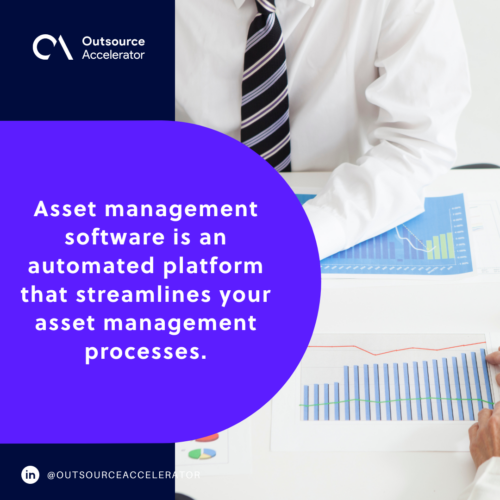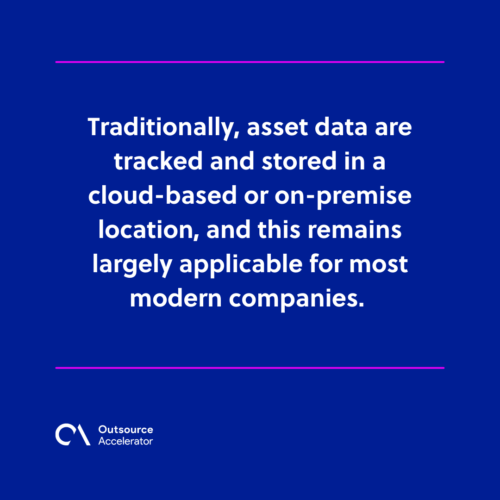Top 20 asset management software

List of asset management software
- Asset Panda
- SAP ERP Suite (EAM)
- Maximo Application Suite
- Oracle Enterprise Asset Management (eAM)
- Accruent Maintenance Connection
- Transcendent EAM CMMS
- Fiix CMMS
- HxGN EAM
- MVP One
- Ramco EAM
- eMaint CMMS
- UpKeep Asset Operations Platform
- PeopleSoft Enterprise Asset Management
- Ellipse EAM
- Fracttal
- AVEVA EAM
- IPS Enterprise Asset Management System
- CGI ARM Suite
- IFS Ultimo
- Mainsaver
Assets are resources that generate value for an enterprise. They should be taken care of and ensure they continue creating value for as long as possible.
To do this, managers and end-users should have access to asset status and guides on how and when to maintain these materials.
Modern technology has led to asset management software (AMS) development. These automated platforms record, track, and monitor all transactions regarding your assets throughout their respective life cycles.
This way, businesses can make information-driven decisions regarding purchasing, upkeep, and disposal of these assets.
This article gives you a quick run-through of AMS systems. More importantly, we have listed 20 of the most widely-used asset management software across various industries.
What does an asset management software do?
At its core, asset management software is an automated platform that streamlines your asset management processes. Its main capability is in recording your asset-related transactions such as:
- Purchases
- Services
- Usage
- Disposal
However, tech advances in the fields of intelligence and automation have empowered AMS platforms to track assets in real-time.

One example is using GPS trackers for trucking and logistics companies, which provide the vehicle’s location and data regarding mileage, gas consumption, and driving schedules.
Adopting an AMS platform will require you to invest resources. However, in the long run, you will have an optimized asset life cycle and savings on otherwise avoidable maintenance and replacements.
4 features to find in an AMS system
Finding asset management software is a major investment. It warrants conducting your due diligence and assessing what options are available and which are aligned with your business goals and objectives.
While each software may offer different interfaces, support services, and extra functionalities, four features are always worth checking out in every AMS:
Asset tracking capabilities
Strip an AMS platform down to its essentials, and you are left with features relating to tracking assets.
Most AMS requires users to enroll an asset, defining parameters such as cost, lifespan, and service schedules. While these are the essentials, there are different ways through which this is achieved.
In this regard, check out for tracking capabilities that suit your unique business needs. Other features like real-time GPS tracking or sensor-based input are not universally applicable, so you might also want to check them out.
Also, you want a platform that is easy to use to make it more accessible. The less technical know-how you require, the faster you can transition into your new software, which also translates to savings in terms of costs and man-hours.
Compatibility and scalability
Most of these platforms are sold as a part of a larger enterprise resource planning (ERP) platform, so compatibility with your existing platform is a consideration.
For example, businesses already using the Oracle ERP would enjoy smoother transactions with the Oracle Enterprise Asset Management (eAM).
You’d also make the most of your investment by finding a flexible service supporting a changing volume and nature of assets.
Your AMS should be able to adapt its services to meet your unique, changing requirements.
Mobility and portability
Traditionally, asset data are tracked and stored in a cloud-based or on-premise location, and this remains largely applicable for most modern companies.
However, there’s an increasing need to remotely access information, especially as 57% of organizations allow their employees to work away from the office.

Aside from making data access more convenient, portable asset management also connects to how the assets are tracked. Location trackers are widely implemented for moving assets such as vehicles and pieces of equipment that are regularly relocated.
Similarly, office equipment like printers and copiers also have activity logs that give users an idea about their usage histories.
Coverage
Aside from the ability to adapt to your changing needs, the volume and type of assets covered by the platform also warrant an investigation.
There are a lot of types of assets involved in an enterprise, and finding a platform that covers all assets you have eliminates the need for another platform. Some types of asset management requirements include:
- Fixed asset management
- Digital asset management
- IT asset management
- Financial asset management
- Infrastructure asset management
20 of the best asset management software
Here we have 20 of the leading asset management software businesses can invest on:
1. Asset Panda
Asset Panda is a favorite among companies with limited budgets. It is a highly configurable cloud-based solution that tracks assets and lets you program interdependencies between those assets.
More importantly, it comes with free mobile apps for Android and iOS with barcode scanning capabilities.
However, this AMS might not be sufficient for more industrial applications. It has no features for remotely accessing machines and suffers from lags when importing larger data sets.
2. SAP ERP Suite (EAM)
SAP is a global industry leader in business automation solutions. Its massive ERP Suite covers almost every aspect of operation, from supplier management to customer relationships.
Its dedicated enterprise asset management module goes beyond basic asset tracking, including maintenance and job scheduling, performance management, and data analytics.
The biggest roadblock to adopting SAP EAM is its cost, reinforcing the idea that Oracle SAP solutions are intended for larger enterprises. It also doesn’t help that its pricing plans are robust, with little room for flexibility.
3. Maximo Application Suite
IBM’s Maximo Application Suite focuses on improving efficiency, operational resiliency, and process reliability.
One of its strongest features is its AI-driven condition-based asset maintenance. It tracks the actual state of an asset and sets up services accordingly, which makes it responsive to unexpected downtime.
Despite being feature-rich and supporting various industry-specific requirements, the IBM AMS platform imposes quite a steeper learning curve, primarily because of its user interface.
4. Oracle Enterprise Asset Management (eAM)
This is the Oracle SAP – eAM equivalent for the Oracle E-Business Suite (EBS), which is an on-premise deployment instead of the cloud-based ERP.
As such, it offers the same customizability and platform stability that makes it a reliable long-term partner for businesses. It is built on the Oracle Database, which can be retrofitted to work with any existing automation solutions you might have.
Similar to its SAP counterpart, cost is also a primary challenge in the EBS-EAM. Additionally, its GUI can be difficult to set up, although this can be adapted and customized for easier use.
5. Accruent Maintenance Connection
One persisting challenge with AMS is the learning curve required, and Accruent Maintenance Connection addresses this head-on.
Intuitive, user-friendly GUI plus a suite of in-app Training Tutorials makes it easy even for non-technical users to adopt and appreciate.
Still, there are still a couple of feature restrictions on this software. For example, you can only enroll in fixed work schedules, making floating schedules unavailable for plotting.
Similarly, it has posed compatibility issues, making migration a massive roadblock for companies.
6. Transcendent EAM CMMS
Promising smart asset management, Transcendent combines enterprise asset management and a computerized maintenance management system (CMMS) in one.
This means that after enrolling your asset into the platform, you can schedule various maintenance procedures, including monitoring work orders.
With support for both on-premise and cloud-based deployment, Transcendent EAM CMMS is quite a flexible app. One minor issue is that the online services can be a bit slow at times.
7. Fiix CMMS
Unlike other full asset management platforms, Fiix CMMS is only focused on automating the maintenance process for your assets. To make up for this, it has massive integration potential, making it an easy partner for a lot of EAM software platforms.
Still, as a CMMS, this Fiix software only caters to a subset of the larger asset management space. It only taps into common functions like scheduling and asset dashboards.
8. HxGN EAM
The Hexagon asset management (HxGN EAM) is an enterprise-level AMS designed for different industries.
It has a comprehensive asset structuring capability that extends to facilitating work orders. It also works with other industry-leading platforms, such as Oracle, IBM, or Mitsubishi, for easier integration.
While it also supports mobile apps for added portability, it’s not the Hexagon app’s strong suit. Navigation is not optimized for mobile, pushing users to wait until they get to a desktop terminal instead.
9. MVP One
MVP One focuses on class-based asset management, making it easy to manage assets of the same type. This is ideal for organizations with extensive logistics requirements, such as managing warehouses or moving equipment a lot.
Aside from class-based arrangement, you can also sort assets by criticality, ensuring that your most important resources are always visible.
However, a particular issue with this platform is its limited navigation capabilities. The search engine is subpar and has limited access to other assets that are low in class or priority.
10. Ramco EAM
Ramco is an emerging multinational leader in business automation, and its EAM software is becoming a preferred partner for certain companies.
This is a cloud-based solution designed to integrate with financials and human capital management (HCM) or as a standalone asset management software.
On the other hand, it can come up short in terms of reporting. Specifically, its graphical analysis feature is limited and hard to come by except for experienced users.
11. eMaint CMMS
eMaint CMMS is a computerized solution perfect for small and medium-sized businesses in the logistics and transport sectors.
It supports multi-site maintenance operations for inventory and spare parts tracking and can automate preventive and predictive maintenance scheduling.
Similar to other apps, eMaint’s app is its limited mobile functionality. While it works as a means of monitoring asset data, the ability to navigate and make changes is quite restrictive.
12. UpKeep Asset Operations Platform
The holistic UpKeep Asset Operations Platform combines standard asset management with maintenance and reliable analytics.
It gives users streamlined access between assets and business operations. It basically combines AMS, CMMS, and application performance management (APM) as needed.
While it has good coverage and a wide range of features, it also has issues with counter-intuitive report generation setups.
13. PeopleSoft Enterprise Asset Management
PeopleSoft is an automation solution developer that was acquired by Oracle. Despite being a legacy product, it remains in wide use, which has prompted its parent company to extend support until 2033.
As such, it no longer has the ability to keep up with modern AMS. More importantly, the app is slowly moving toward becoming a funnel for users to transition into other Oracle solutions.
14. Ellipse EAM
Ellipse EAM by Hitachi is an enterprise asset management platform with an intuitive interface, making it a preferred software for applications requiring non-technical users at one end.
It comes with a full set of features to help you monitor and maintain assets throughout their life cycles.
The main drawback of Ellipse EAM is its cost. Intended for larger enterprises, the upfront and subscription costs are not accessible for smaller businesses.
15. Fracttal
In terms of accessibility, Fracttal is one option businesses shouldn’t skip. For starters, it offers a free version that lets you test out its capabilities and see whether it’s a good fit for your business.
Feature-wise, it helps manage assets with an emphasis on the use of business intelligence. However, Fracttal leans more toward CMMS since here is where it shines.
Scheduling preventive and predictive maintenance and consolidating work orders are some of its best-in-class features.
16. AVEVA EAM
AVEVA EAM offers a comprehensive one-stop shop for asset optimization, covering inventory and maintenance management requirements.
It can even be set up to cover work management requirements, labor, materials, tools, plans, and even subcontractor requirements. As such, this software might be overwhelming for first-time users, even for those experienced in AMS use.
Also, it could use some improvements in terms of generating cost estimates, schedule projections, and other data-driven reporting needs.
17. IPS Enterprise Asset Management System
For a robust AMS that is also cost-effective, the IPS Enterprise Asset Management System can be a good choice.
Asset tracking from procurement to maintenance, including inventory procurement, are some features that can help companies organize their assets.
Its complexity and limited integration options offset its advantages in terms of features and costs. This makes it challenging to implement for new users, but it is worth the effort once deployed.
18. CGI ARM Suite
For smaller companies looking for portability, the CGI ARM Suite is a reliable and flexible asset and resource management (ARM) solution.
This is web-based, which means anyone can access their company’s asset records by logging into any internet browser.
The platform meets most requirements and is exceptionally portable. Once common customer concern is in the product’s support team, the lack of standard competencies among the consultants makes the project a hit-or-miss endeavor.
19. IFS Ultimo
IFS Ultimo is a flexible platform that boasts a wide range of integrations, making it easy to adopt even for organizations with existing automation platforms. Similarly, it is user-friendly, making it easy to pull out data and generate reports.
Cost-wise, IFS Ultimo isn’t as expensive as other entries on this list. What drives the bill for new platform users is the consultation fees, which are all but guaranteed unless you have a dedicated in-house team to manage transitions.
20. Mainsaver
Mainsaver has established itself as a CMMS platform with a 39-year track record, with features that overlap with the broader asset management space.
It has customizable dashboards that can be integrated with sensing solutions, allowing your decision-makers to see data remotely and monitor assets in real-time.
As a general-purpose tool, Mainsaver has limited utility when serving specialized applications. Aside from this minor restriction, it’s a good tool anyone can test out without overextending resources.
Manage all your assets efficiently
By leveraging the technological advantages of modern asset management software, you can:
- Extend your asset’s lifespan
- Minimize otherwise avoidable expenses
- Optimize the return on investment for your organization
While it requires a learning curve, plus a few organizational changes, it puts your company at a better position moving forward.







 Independent
Independent




